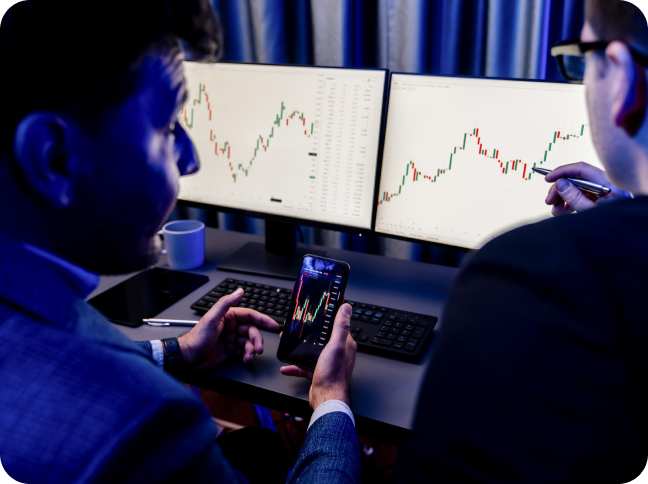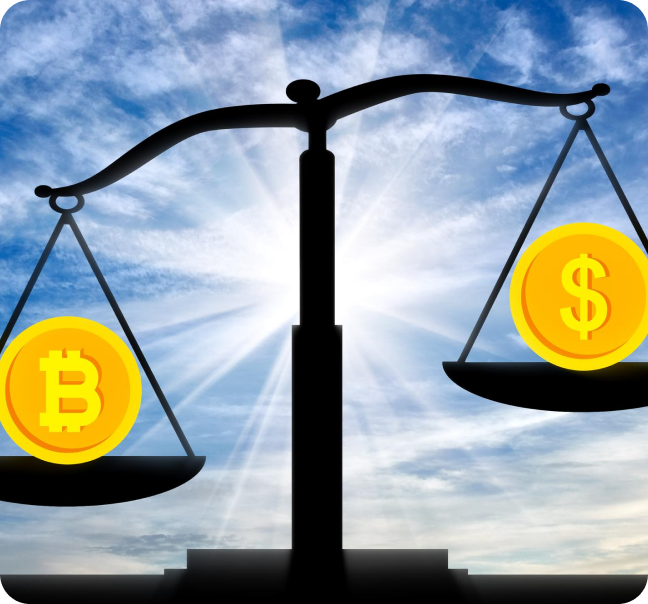


Both the cryptocurrency and stock markets are attractive propositions for traders looking to profit from daily price swings
Digital assets are typically more volatile than stocks, with prices capable of swinging dramatically in short periods
There are opportunities and risks inherent to both markets, with some day traders opting to take advantage of lucrative opportunities in each
What are the main differences between day trading in the cryptocurrency market compared to the stock market? Here, we assess the risks and opportunities of both markets and evaluate how both compete for the day trader’s dollar.
With day trading, investors attempt to identify and execute trades within a limited time-frame (no more than one day, as the name suggests) in a bid to capitalize on short, sharp market movements and, in turn, generate profits.
Day trading is applied to a plethora of financial markets, including forex, commodities, stocks, and cryptocurrencies. Each market has unique characteristics that present both new challenges and fresh opportunities for the day trader.
The stock market and cryptocurrency market, in particular, have become popular venues for day traders in recent times. The stock market, with its regulated environment and predictable patterns, attracts traders seeking stability and growth. Meanwhile, the cryptocurrency market, known for its high volatility and rapid price movements, offers the potential for substantial profits, albeit with higher risks.

Let’s take a closer look at the difference between cryptocurrency and stocks, and assess how both compete for the day trader’s dollar. Day trading in the stock market involves analyzing historical data, market trends, and company performance. Stocks represent ownership in a corporation and are influenced by earnings reports, economic indicators, and geopolitical events.

In contrast, the cryptocurrency market operates 24/7, driven by market sentiment, news events, and technological developments. Cryptocurrencies are digital assets that use cryptography for security and operate on decentralized networks. The rapid price movements in the crypto market can lead to significant profits, but also pose substantial risks due to its unregulated nature and potential for market manipulation.
Both the stock market and cryptocurrency market offer distinct opportunities and risks for day traders. Success in either field demands dedication to research, discipline, and effective risk management. By understanding the unique dynamics of each market, day traders can better navigate the challenges and capitalize on the opportunities presented by both stocks and cryptocurrencies.
Cryptocurrencies are digital or virtual currencies that use cryptography for security. These digital assets operate on decentralized networks based on blockchain technology, a distributed ledger backed up and secured by a global network of computers. This unique setup ensures transparency and security in transactions, making the crypto market highly attractive to tech-savvy day traders.
Bitcoin (BTC): Launched in 2009 by an unknown person or group using the pseudonym Satoshi Nakamoto, Bitcoin was the first cryptocurrency and remains the most well-known, liquid, and valuable. Often dubbed “digital gold” due to its limited supply and store of value characteristics, Bitcoin continues to dominate the crypto market.

Ethereum (ETH): Introduced in 2015 by developer Vitalik Buterin, Ethereum is a decentralized platform that enables smart contracts and decentralized applications (dApps) to be built and run without any downtime, fraud, or interference from a third party. Its native cryptocurrency, ETH, is the second-largest by market capitalization, making it a popular choice for crypto trading.

Altcoins: This catch-all term encompasses all digital assets other than Bitcoin and includes coins as varied and unique as Dogecoin, XRP, Shiba Inu, Solana, and more. Each altcoin presents unique opportunities and risks, contributing to the overall market volatility and dynamics of the crypto market.

Stocks represent ownership in a corporation and constitute a claim on part of the company’s assets and earnings. The stock market offers a wide range of investment opportunities, categorized based on various factors such as market capitalization, industry, and growth potential.
Blue-Chip Stocks: These are shares of well-established companies with a history of reliable performance and financial stability. Examples include Apple (AAPL), Microsoft (MSFT), and Johnson & Johnson (JNJ). Blue-chips are known for their steady growth, dividends, and lower risk compared to other stocks, making them a cornerstone of stock market investments.
Penny Stocks: Shares of small companies that trade for less than $5 per share, penny stocks are highly speculative and volatile, often traded over-the-counter (OTC) rather than on major exchanges. Their low price and potential for high returns attract adventurous day traders willing to embrace significant risk.
Growth Stocks: Shares of companies expected to grow at an above-average rate compared to other companies, growth stocks typically do not pay dividends. Instead, companies reinvest earnings to fuel further growth. Tech companies like Tesla (TSLA) and Amazon (AMZN) are prime examples, offering high potential returns for stock traders.
Value Stocks: These are shares of companies that are considered undervalued in price based on their fundamentals, such as earnings, dividends, and sales. Investors buy value stocks with the expectation that their price will eventually reflect the company’s true worth, presenting a more conservative approach in the stock market.
Understanding the dynamics of both the cryptocurrency and stock markets is crucial for day traders. Each market presents unique opportunities and challenges, influenced by different factors that affect their respective market capitalization and price movements. Whether engaging in crypto trading or stock trading, having a comprehensive understanding of these markets’ fundamentals can significantly enhance a trader’s strategy and potential for success.
The volatility of a market refers to the frequency and magnitude of price movements. Digital assets are generally more volatile than stocks, with prices capable of swinging dramatically in short periods. This volatility is due to several factors, including lower market liquidity, regulatory uncertainties, and the nascent stage of the crypto market.
The crypto market is known for its extreme volatility. For example, Bitcoin’s price fluctuated from around $30,000 in January 2021 to over $60,000 in April 2021, before tumbling back down to $30,000 by July 2021. Such extreme swings can occur within hours or days, driven by market sentiment, news events, regulatory announcements, and technological developments. This rapid price movement presents both significant opportunities and substantial risks for crypto day traders.
While the stock market is also subject to volatility, it is generally less extreme compared to cryptocurrencies. Stock prices are influenced by earnings reports, economic data, interest rates, and geopolitical events. For example, the S&P 500 witnessed a significant drop of about 34% in February-March 2020 due to the COVID-19 pandemic but recovered quickly with a 70% increase by the end of 2020. Despite being volatile, stock market movements tend to be more predictable, allowing traders to use historical data and market trends to inform their trading strategies.
Volatility presents both opportunities and risks for day traders. High volatility can lead to significant profits from price movements, but it also increases the risk of substantial losses.
The rapid price movements of cryptocurrencies are more unpredictable than those of stocks, offering substantial profit opportunities. Smart day traders can anticipate and exploit sudden movements using a combination of technical analysis, news-based trading, market sentiment, and even instinct. The crypto market runs 24/7, providing traders with a round-the-clock opportunity to make successful trades. Experienced traders who understand the market dynamics can leverage these opportunities for quick trades and potential small profits from small price movements.
Day traders in the stock market can benefit from earnings reports, market news, and economic data releases. Volatility in this market is often more predictable, and traders can use historical data and technical analysis to inform their trading strategies. Stock market day traders can also exploit the influx of liquidity that occurs as the trading day opens in the Singapore, London, and New York time zones. This predictable volatility allows traders to plan their trading strategy more effectively and capitalize on short-term price movements.
Although the stock market is more regulated, it still carries risks such as sudden market crashes, corporate scandals, and economic downturns. Leverage and margin trading in stocks can also present risks of amplified losses. Successful day traders must maintain trading discipline and risk tolerance to navigate these risks effectively. Understanding the market dynamics and having a deep understanding of technical indicators and market trends can help mitigate these risks and enhance trading success.
In conclusion, both the crypto market and the stock market offer unique opportunities and risks for day traders. The key to successful day trading lies in understanding the specific dynamics of each market, leveraging technical analysis, and maintaining effective risk management strategies.
Ultimately, the day trader’s selection of either stocks or cryptocurrencies will generally be dictated by his or her own knowledge base and level of risk tolerance. Both stock trading and crypto trading offer unique opportunities and challenges that cater to different trading styles and preferences.
If stock trading represents a traditional financial market, then the cryptocurrency market can often be thought of as ‘stocks on steroids,’ with much more volatile price movements and greater opportunity for both loss and profit. The stock market is heavily regulated by entities such as the Securities and Exchange Commission, which provides a level of stability and predictability. In contrast, the crypto market, being relatively new and less regulated, experiences higher market volatility and rapid price swings, attracting both thrill-seekers and risk-tolerant day traders.

Day trading strategies in the stock market typically rely on a combination of technical analysis, market trends, and economic indicators. Successful day traders in this market often leverage historical market data, technical indicators, and market dynamics to predict short-term price movements and execute trades within the same trading day. Stock trading involves analyzing publicly traded companies, market capitalization, and trading discipline, allowing traders to capitalize on predictable price movements and market trends.
On the other hand, day trading crypto requires a deep understanding of the digital assets market, including Bitcoin, Ethereum, and various altcoins. Crypto day traders need to stay abreast of news-based trading opportunities, regulatory announcements, and technological developments that can significantly impact crypto asset prices. The highly volatile nature of the crypto market demands a different set of day trading strategies, focusing on rapid price movements and the potential for quick trades and small profits within a 24/7 trading environment.
Crypto trading offers the allure of high rewards due to its significant risk and potential for rapid price appreciation. However, it also requires robust risk management strategies to mitigate the dangers of market manipulation, exchange hacks, and regulatory uncertainties. Crypto investors and day traders must exercise caution and maintain a deep understanding of the market dynamics to navigate the volatile landscape successfully.
While stark differences do exist between stock trading and crypto trading, success in either field demands the same level of dedication to research, discipline, and risk management. Experienced traders who can adapt their trading strategy to the unique characteristics of each market stand to benefit from the diverse opportunities presented by both financial markets.
Moreover, some day traders have been known to play both markets, utilizing their knowledge of market dynamics and technical analysis to maximize their trading goals. By diversifying their trading portfolio across stocks and cryptocurrencies, traders can potentially balance their risk tolerance and capitalize on the strengths of each market.

In conclusion, whether one chooses to engage in stock trading or crypto day trading, the key to successful day trading lies in understanding the unique aspects of each market, employing effective day trading strategies, and maintaining a disciplined approach to risk management. The dynamic nature of financial markets, coupled with the allure of significant rewards, continues to attract day traders to both traditional stocks and the burgeoning crypto industry.